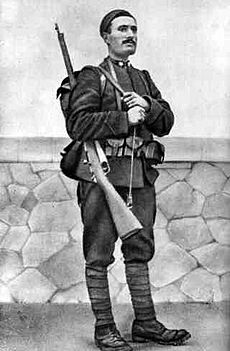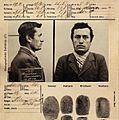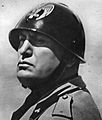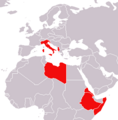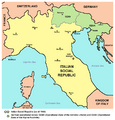Benito Mussolini facts for kids
Quick facts for kids
Benito Mussolini
|
|
|---|---|
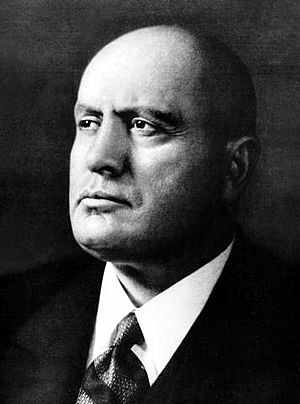 |
|
| Head of Government of Italy and Duce of Fascism |
|
| In office 24 December 1925 – 25 July 1943 |
|
| Monarch | Victor Emmanuel III |
| Preceded by | Office created |
| Succeeded by | Office abolished |
| 27th Prime Minister of Italy | |
| In office 31 October 1922 – 25 July 1943 |
|
| Monarch | Victor Emmanuel III |
| Preceded by | Luigi Facta |
| Succeeded by | Pietro Badoglio |
| Duce of the Italian Social Republic | |
| In office 23 September 1943 – 25 April 1945 |
|
| Preceded by | Office created |
| Succeeded by | Office abolished |
| First Marshal of the Empire | |
| In office 30 March 1938 – 25 July 1943 |
|
| Preceded by | Office created |
| Succeeded by | Office abolished |
| Personal details | |
| Born |
Benito Amilcare Andrea Mussolini
29 July 1883 Predappio, Forlì Kingdom of Italy |
| Died | 28 April 1945 (aged 61) Giulino di Mezzegra, Como Kingdom of Italy |
| Resting place | San Cassiano cemetery, Predappio, Forlì, Italian Republic |
| Political party | Republican Fascist Party (1943–1945) National Fascist Party (1921–1943) Italian Fasci of Combat (1919–1921) Fasci of Revolutionary Action (1914–1919) Autonomous Fasci of Revolutionary Action (1914) Italian Socialist Party (1901–1914) |
| Height | 5' 6½" (1.69 m) |
| Spouses | Ida Dalser (m. 1914-?) Rachele Mussolini (m. 1915-1945, his death) |
| Relations | Alessandra Mussolini (granddaughter) |
| Children | Benito Albino Mussolini Edda Mussolini Vittorio Mussolini Bruno Mussolini Romano Mussolini Anna Maria Mussolini |
| Profession | Dictator, politician, journalist, novelist, teacher |
| Signature | |
| Military service | |
| Allegiance | |
| Branch/service | |
| Years of service | active: 1915–1917 |
| Rank | First Marshal of the Empire Corporal |
| Unit | 11th Bersaglieri Regiment |
| Battles/wars | World War I World War II |
Benito Amilcare Andrea Mussolini (born July 29, 1883 – died April 28, 1945) was an Italian politician and journalist. He served as the Prime Minister of Italy from 1922 to 1943. He was also the leader of the National Fascist Party, which was a powerful political group in Italy.
Contents
Biography
Early Life and Career
Benito Mussolini was named after Benito Juárez, a Mexican leader who opposed the political influence of the Roman Catholic Church. Mussolini's father was a blacksmith and didn't want the church to interfere in government matters.
Before becoming a politician, Mussolini worked as a newspaper editor. This job helped him learn how to use information to influence people's opinions. He also spent some time as an elementary school teacher.
At first, Mussolini was a socialist. Socialists believe in sharing wealth and power more equally. However, he was kicked out of the socialist party when he supported Italy joining World War I. After this, he created a new political idea called Fascism. This idea combined strong feelings of nationalism (love for one's country) with some socialist views.
How Mussolini Gained Power
In 1922, Mussolini and a large group of his followers, known as the "Black Shirts," marched on Rome. They threatened to take control of the government. The King of Italy, Vittorio Emanuele III, decided to let Mussolini form a government. He made Mussolini the prime minister.
Over the next five years, Mussolini slowly took more and more power. By 1927, he had become the dictator of Italy. He created a secret police force called the OVRA. This group arrested, scared, or even killed people who were against his rule. Only the King and Mussolini's own Fascist party could challenge his power.
Mussolini's Fascist Rule
Mussolini's type of Fascism, called "Italian Fascism," was different from Nazism, the racist idea followed by Adolf Hitler in Germany. While Mussolini believed in the strength of the Italian nation, he didn't believe in the idea of "pure races" like Hitler did. He once said, "Race? It is a feeling, not a reality. Nothing will ever make me believe that biologically pure races can be shown to exist today."
Mussolini dreamed of making Italy a new Roman Empire. To achieve this, he began to expand Italy's territory. In 1923, he attacked the island of Corfu. In 1924, he took over the city state of Fiume.
In 1935, he attacked the African country of Abyssinia (now Ethiopia). His forces took control of it in 1936. Because of this attack, Italy was removed from the League of Nations, an international organization that aimed to prevent wars. In 1939, Mussolini also occupied the country of Albania. In 1936, Mussolini formed an alliance with Adolf Hitler, the dictator of Germany.
Mussolini's Downfall and Death
In 1940, Mussolini led Italy into World War II on the side of the Axis countries. He attacked Greece, but his army failed to conquer it. In 1943, the Allied forces landed in Southern Italy.
The Fascist party and King Vittorio Emanuel III removed Mussolini from power and put him in jail. However, German soldiers freed him. The Germans then made him the ruler of a small part of Central Italy called the Italian Social Republic. This was a "puppet state," meaning it was controlled by Germany.
As the war was ending, Mussolini tried to escape to Switzerland with his companion, Clara Petacci. But they were both caught and shot by Italian resistance fighters known as partisans. Their bodies were later publicly displayed for everyone to see.
After His Death
After World War II, some new political groups in Italy, called Neo-Fascist movements, gained some support. One of the most well-known was the Movimento Sociale Italiano. Mussolini's granddaughter, Alessandra Mussolini, has also expressed views similar to Fascism.
Interesting Facts About Benito Mussolini
- He was the youngest Prime Minister in Italy's history.
- Mussolini slowly removed all forms of democratic government to make himself dictator of Italy. This made him Europe's first fascist dictator in the 20th Century.
- Mussolini spoke four languages: English, German, French, and Italian.
- Mussolini wanted Italy to become a new Roman Empire.
- His nickname was “Il Duce,” which is Italian for ”The Leader.”
- He was a bully in his childhood and even stabbed others at school.
- His Italian army in World War II was not very strong.
- For a short time, he was a school teacher and a journalist.
- Mussolini was discharged from the army after a bomb exploded in his trench and injured him.
Images for kids
-
Mussolini's booking file following his arrest by the police on 19 June 1903, Bern, Switzerland
-
Mussolini and the Quadrumvirs during the March on Rome in 1922: from left to right: Michele Bianchi, Emilio De Bono, Italo Balbo, and Cesare Maria De Vecchi
-
Socialist leader Giacomo Matteotti was murdered a few days after he openly denounced fascist violence during the 1924 elections.
-
From 1925, Mussolini styled himself Il Duce (the leader)
-
Mussolini inspecting troops during the Italo-Ethiopian War
-
On 25 October 1936, an alliance was declared between Italy and Germany, which came to be known as the Rome-Berlin Axis.
-
Italian Empire in 1939
-
Marshal Pietro Badoglio succeeded Mussolini as Prime Minister.
-
Mussolini with Adolf Hitler in Berlin, 1937
See also
 In Spanish: Benito Mussolini para niños
In Spanish: Benito Mussolini para niños


